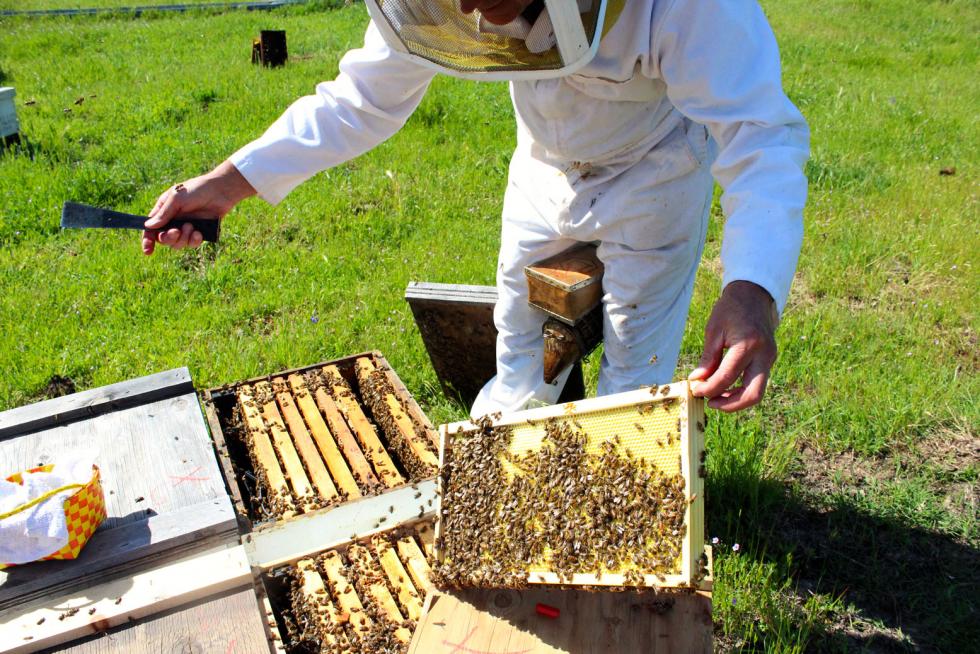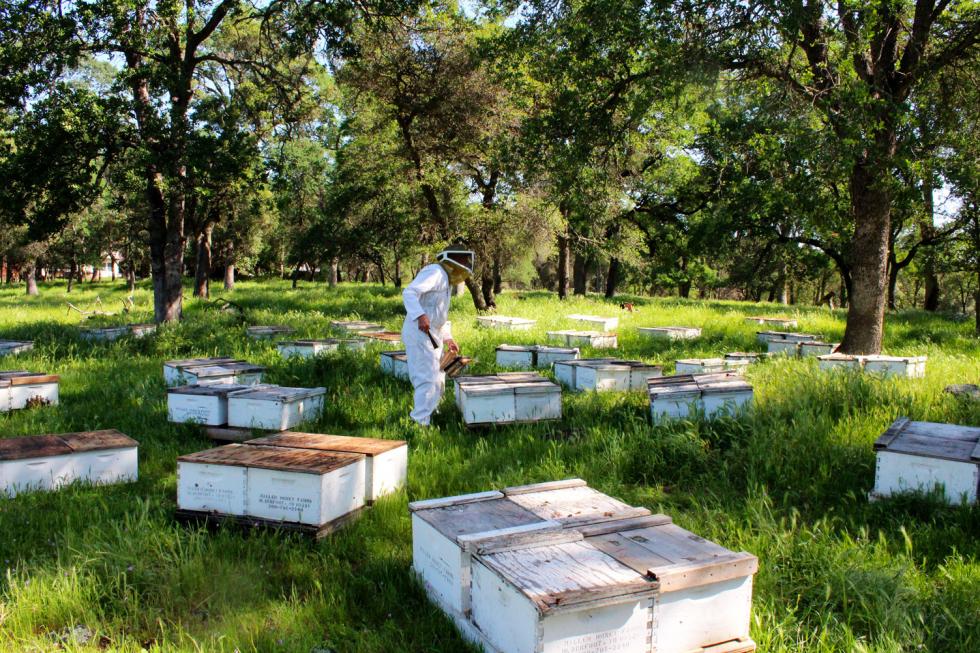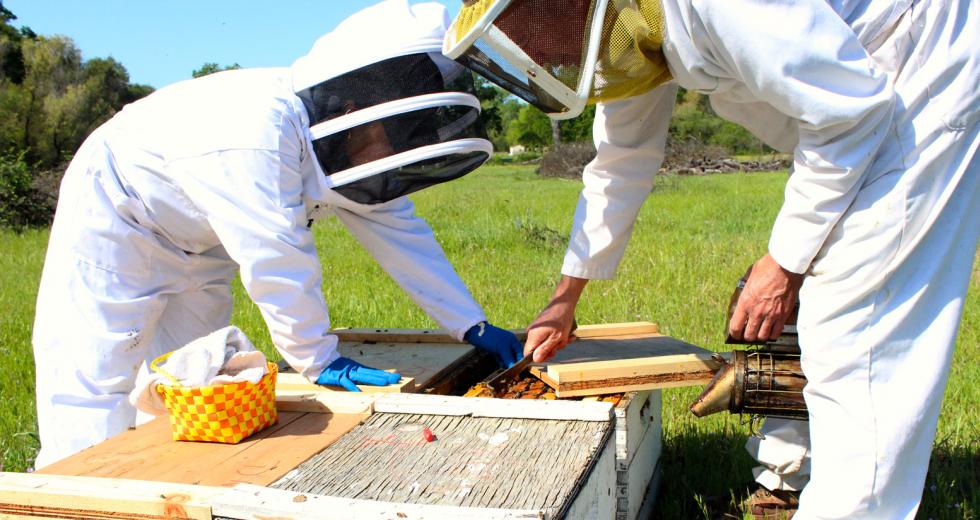On a cloudless April morning, I zip on a lavender-colored getup — the “Barney” outfit, as John Miller calls this particular bee suit, relegated to smallish adult visitors to his property, Miller Honey Farms, in Newcastle. He then points me in the direction of the “sandbox,” advising its use before our three hours out in bee yards around Placer County. I abide.
We hop in Miller’s truck, joined by his Spanish-speaking employee Fatima Lopez. Miller asks if I understand the language. Sadly, my three years of high school Spanish escape me. “That means we can throw down Spanish profanities and we’ll be fine,” he declares to Lopez. Miller, who is 61 years old, has large blue eyes and a wit so dry that at times his humor doesn’t sink in until it’s much too late to laugh.
Miller is a fourth-generation commercial beekeeper — or apiarist — who for the past 30 years has overseen Miller Honey Farms, with locations in California, North Dakota and Idaho. Bees pollinate about one-third of the world’s fruits, vegetables and nuts, and Miller’s business sells pollination services to some big-time farmers in California and Washington. They also sell honey.
The Barney suit is already making me warm; it doesn’t help that the truck’s heater is turned on to protect the valuables within — a collection of cells, each about the size and shape of a thimble, containing baby queen bees. Three days earlier, Miller’s crew made new hives and those honey bees lack a queen; quite an upsetting predicament for a bee. Lopez and Miller have been “sticking queens,” which involves placing one queen each in 500 hives a day for 20 days. It’s Day 14 and I’m tagging along for the ride.
We head down the driveway passed Miller’s mandarin orchard on our way to a property where his company houses beehives in exchange for free pollination and honey. It’s an “extraordinary trust” with the 60-plus landowners who agree to keep thousands of stinging insects on their properties, Miller says. The company has 17,000 hives total and simply not enough land of its own on which to store them all.
Out on the main road, we pass what appear to be two ravens (or crows, perhaps?) gnawing on road kill. Miller glances at the feast. “When I come back, I hope it’s not as a vulture, because I don’t want to eat skunk.”
Keeping a Hive Alive
Miller Honey Farms traces its history back to 1917 when N.E. Miller sent his son Earl to Idaho in search of bee pasture. In 1954, Earl’s son Neil took the reigns. In 1970, they started a branch in North Dakota, and in 1974 expanded to Newcastle. Neil sold the outfit to his son John in 1997.
John Miller, owner of Miller Honey Farms, examines one of his
hives at a bee yard in Placer County (Photography Sena Christian)

Northern California’s temperate climate, fertile soil and advanced water-supply system make the region a prime spot for commercial beekeeping, and even more so nowadays. Why’s that? Almonds, which need bees — lots and lots of bees. No bees means no almonds. While almonds may be a discretionary food, this crop has skyrocketed to the state’s second most-valuable agricultural commodity (behind milk and ahead of grapes). But an almond orchard is a food desert for bees when trees aren’t in bloom, so pollination wouldn’t naturally happen — that’s why as demand for almonds has sharply increased, so has the cost of pollination services.
The number of commercial beekeepers (those with 300 or more hives) in the U.S. is small, with fewer than 2,000 left in this tribe of, as Miller says, “fiery, independent misfits,” according to the U.S. Department of Agriculture. Only 110 commercial beekeeping operations are registred in California. Miller is one of three in Placer County, and the 2011 book “The Beekeeper’s Lament” describes him as one of the nation’s foremost migratory beekeepers, who often move colonies during the prime pollination seasons of late-winter and early-spring to service different farmers.
We may have 1,600 native-bee species in California — and 300 indigenous to the greater Sacramento region — but it’s the industrious honey bee that gets all the glory. One reason: their fidelity. When a honey bee pollinates plums, for instance, she stays with those plums until the plant stops yielding nectar. She won’t switch between plums and apples. “That’s why you don’t see ‘plapples,’” Miller explains.
At the first site, Miller opens the lids of hives and uses his smoker to calm the anxious bees (about 8,000 in each box), as Lopez gently inserts the cell containing the baby queen bee. Lopez is one of 20 year-round employees; others are on the H-2A visa for temporary agricultural workers — they typically arrive from Mexico in mid-January and return home in mid-November. Lopez, Miller says, works harder than three white guys combined.
Miller pulls out a wooden frame so I can watch up close as worker bees begin grabbing mouths-full of food while they still can … this “dragon” with the smoker must be about to destroy their home! When not eating, they graze the queen for reassurance, just like a human child would his mama.The first test for the baby queen bee is to chew her way out of the cell. The second test is whether she’ll be accepted into the colony. If not, the other bees promptly sting her to death. It takes time for a virgin queen to start mating and then to lay her eggs. So in a few weeks, Miller will open each box again to evaluate the queen’s egg-laying pattern. If all looks good, then that’s great. Otherwise, a beekeeper may have to chalk that colony up as a loss; a queen needs to adequately reproduce for a hive to survive.
Not long ago, a 5-percent loss brought Miller major heartache. But in 2014-15, commercial beekeepers in the U.S. reported a 42-percent loss of colonies, according to the Bee Informed Partnership, which identified an 18-percent loss as an acceptable rate. The plight of bees can be attributed to the destructive varroa mite, increased use of pesticides that kill indiscriminately, loss of bee habitat and forage due to development and drought, and colony collapse disorder. Beekeeping, Miller says, has changed more in the past three decades than in all the years since honey bees were introduced to this country in the 1600s. Keeping a hive alive today is a lot harder now than it used to be.
Unfazed by the thousands of bees buzzing within inches of me, I ask Miller about the haphazardness of the boxes spread out around the yard. It’s intentional, he explains, so when the queen goes out to mate, she can figure out how to return to her own home. Lopez alerts her boss to something near the hive, which he scoops up. “Come see some wildlife,” he says, shoving a curled-up black widow into my face. He’s really having fun now.
John Miller’s company, Miller Honey Farms, places beehives on
properties throughout Placer County in exchange for providing
free pollination services and honey. (Photography Sena Christian)

His Life’s Work
But I also see Miller’s frustrated side — the one that surfaces when discussing Americans’ ignorance about their food supply. Take pesticides: At the same time consumers decry the use of synthetic pesticides in agriculture, they want flawless fruits and vegetables available year-round from the grocery store.
“We humans aren’t very good at pesticide use,” he says. “We’re better than 40 years ago, but pesticides is a 9-pound hammer brought against a bug.” Neonicotinoids (a class of insecticides), in particular, seem bad for bees. “I hope I live to see a time of dramatically lower pesticide use,” Miller says. But he imagines that will occur during his 7-year-old grandson Oliver’s lifetime, not his own.
Some consumers, he points out angrily, also declare GMOs evil, while forgetting that for generations farmers have selected for the best traits — just without manipulating genes — and the world has a growing population to feed (projected to reach nearly 10 billion by 2050). Two food movements he does appreciate: Slow Food and Farm-to-Fork. He pauses to show me a bee on his finger that looks distinctly different from a worker bee or queen: “That’s a drone. Also known as the village idiot.”
We drive through a meadow to reach the third and final bee yard for the day. “Look at those poppies and baby’s breathe,” Miller says in awe. As he works, I feel a tingle on my head under my hat and veil. Is it a bee? Yep, for sure. Here comes the pain, slow and sharp. Trying to act cool, I calmly alert Miller to my plight: “Um, I think a bee is stinging my head.” He helps me out and I pretend everything is back to normal (but the pain is spreading! Should I go to urgent care?!). The rest of the morning is a complete and utter blur.
Commercial beekeeping, I’ve determined, isn’t for everyone. But it’s definitely for Miller, who says repeatedly throughout the morning that he’s got the best job on earth. Miller, though, is now beginning to think about transitioning his business to his son Jason, who’s someone he can trust his life’s work to. Maybe someday even his grandson will be interested in taking over the family business. “If I’m allowed to introduce Oliver to the art of beekeeping,” Miller says, “mine will have been a successful life.”



